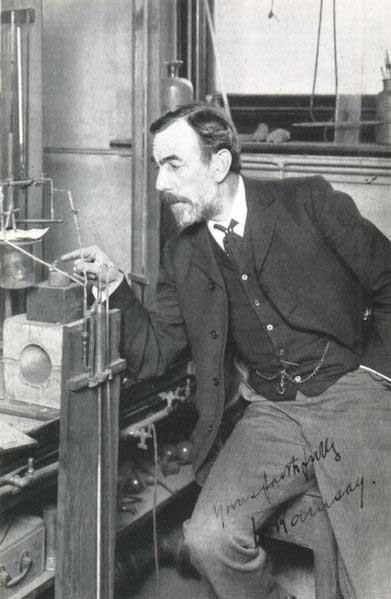
William Ramsay
Sir William Ramsay (October 2, 1852 – July 23, 1916) was a Scottish chemist who discovered the noble gases and received the Nobel Prize in Chemistry in 1904 (along with Lord Rayleigh who received the Nobel Prize in Physics that same year for the discovery of argon).
Ramsay was born in Glasgow, the son of William Ramsay, C.E. and Catherine, née Robertson. He was a nephew of the geologist Sir Andrew Ramsay.
He studied at the University of Glasgow under Thomas Anderson and then went to study in Germany at the University of Tübingen with Fittig where his doctoral thesis was entitled “Investigations in the Toluic and Nitrotoluic Acids”. He returned to Glasgow as Anderson's assistant at the Anderson College. He was appointed Professor of Chemistry at Bristol in 1879 and married Margaret Buchanan in 1881. In the same year he became the Principal of Bristol University and somehow managed to combine that with active research both in organic chemistry and on gases.
In 1887 he succeeded Alexander Williamson to the prestigious chair of Chemistry at University College London. It was here that his most celebrated discoveries were made. As early as 1885–1890 he published several notable papers on the oxides of nitrogen developing the skills that he would need for his subsequent work.
On the evening of April 19th 1894 Ramsay attended a lecture given by Lord Rayleigh. Rayleigh had noticed a discrepancy between the density of nitrogen made by chemical synthesis and nitrogen isolated from the air by removal of the other known components. After a short discussion he and Ramsay decided to follow this up. By August Ramsay could write to Rayleigh to announce that he had isolated a heavy component of air previously unknown which did not appear to have any obvious chemical reactivity. He named the gas "argon". In the years that followed he discovered neon, krypton, and xenon. He also isolated helium which had been observed in the spectrum of the sun but had not been found on earth. In 1910 he also isolated and characterized radon.
He died at High Wycombe, Buckinghamshire, on July 23, 1916 and was buried at St Laurence's Church, Slough in the same church as William Herschel was buried.
The current upper school Sir William Ramsay School, based in Hazlemere in High Wycombe is named after him.
Ramsay lived in Hazlemere until his death. The school was built in 1976.
Biography: Morris Travers "The Life of Sir William Ramsay", Arnold, London, 1956.
Retrieved from "http://en.wikipedia.org/"
All text is available under the terms of the GNU Free Documentation License

